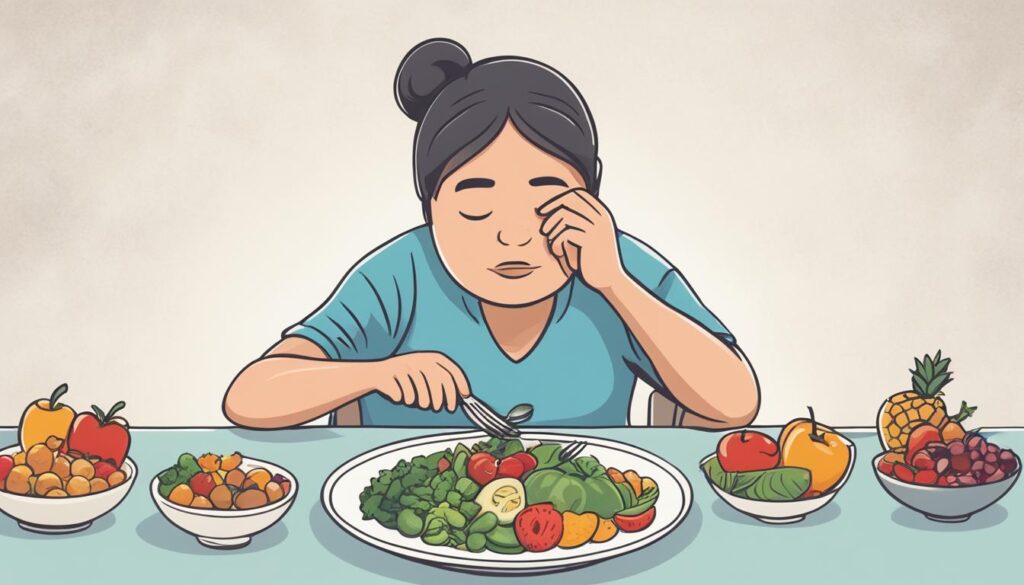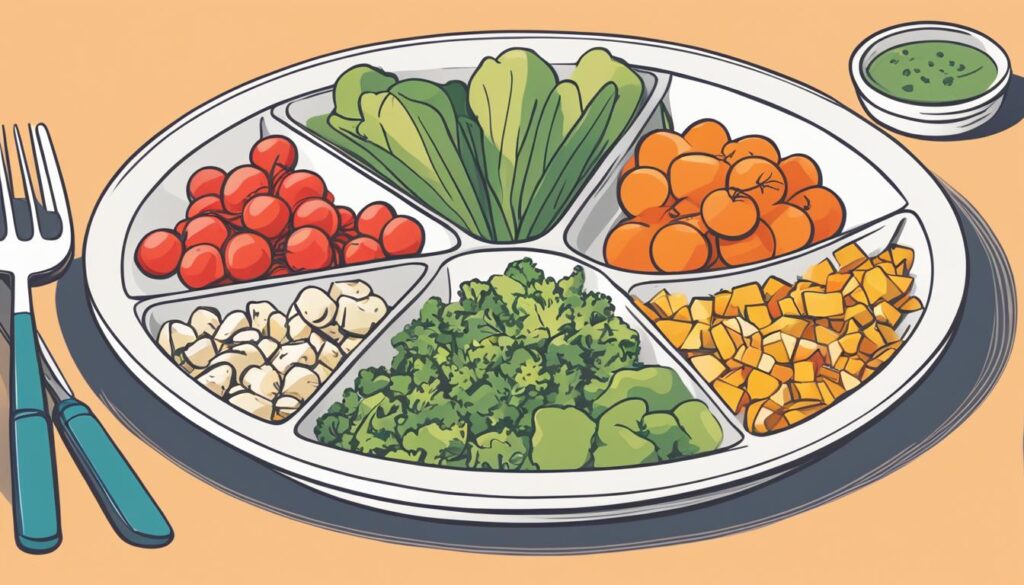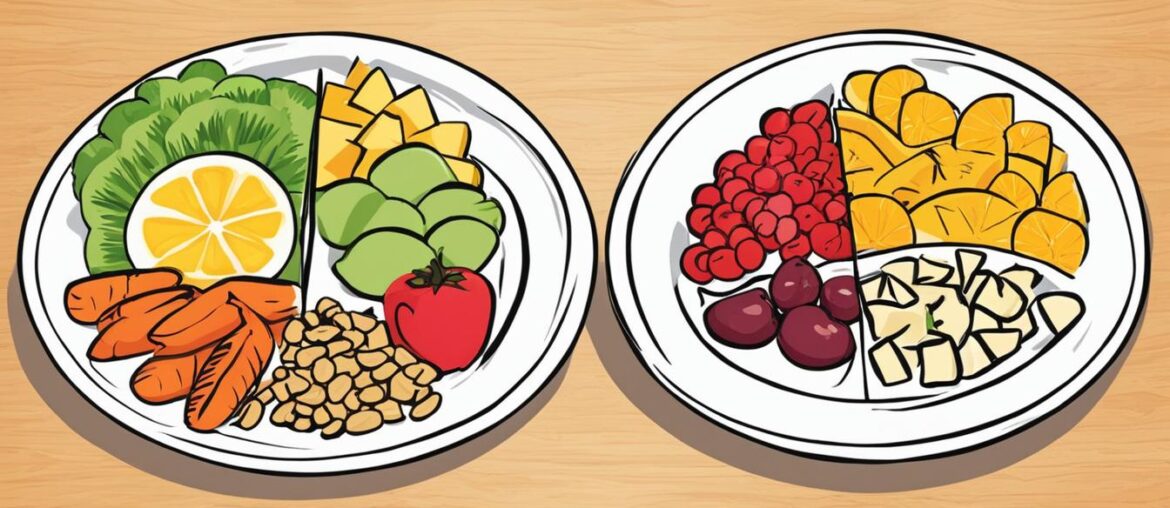When it comes to maintaining a healthy lifestyle, portion control plays a crucial role in managing your diet. With portion sizes of some foods increasing over the years, it's important to be mindful of how much we eat. Ultraprocessed foods and beverages, in particular, are being sold in larger sizes than ever before, which can contribute to overeating and weight gain.
By practicing healthy portion control, we can not only prevent obesity but also improve our overall well-being. Here are some strategies and tips for mastering portion control and achieving a balanced and healthy diet:
Key Takeaways:
- Be mindful of the portion sizes of ultraprocessed foods and beverages, as they are often sold in larger sizes.
- Opt for smaller sizes when buying foods like chocolate, french fries, and soda.
- Avoid eating directly from the package to be more aware of portion sizes.
- Choose plant-based options and use portion control tools like measuring cups.
- Practice mindful eating by paying attention to hunger and fullness cues.
The Impact of Portion Sizes on Health
Larger portion sizes can have a significant impact on our health. Foods like chocolate, french fries, hamburgers, and soda are being sold in larger sizes than ever before, tempting us to consume more without realizing the consequences. The availability of larger beverage sizes has also increased, leading to excessive calorie intake.
Eating very large portions on a regular basis can contribute to weight gain and a range of health conditions, including heart disease, type 2 diabetes, sleep apnea, osteoarthritis, and gallbladder disease. It's important to understand that portion sizes have a direct impact on our overall well-being, and being mindful of our choices is crucial.
Fortunately, there are various portion control tools and strategies available to help us manage our portions and make healthier eating choices. Let's explore some of these tools:
The Portion Control Plate
The portion control plate is a useful tool for visually understanding and planning our meals. It consists of labeled sections for different food groups, making it easy to create well-balanced meals. With a portion control plate, you can ensure that you're getting the right amount of protein, vegetables, carbohydrates, and healthy fats in each meal. It acts as a visual guide, ensuring that you're not overeating any particular food group.
The Portion Control Guide
The portion control guide provides a comprehensive overview of portion sizes for different food groups. It helps us understand what a single serving size looks like for various foods, allowing us to make informed choices when dishing out our meals. By following the portion control guide, we can avoid unintentionally consuming excessive portions and maintain a healthy balance in our diet.
Portion Control Tools and Containers
Portion control tools and containers are practical aids that help us measure and manage our food portions accurately. These tools can include measuring cups, food scales, and portion control containers. They allow us to portion out our meals and snacks according to recommended serving sizes, empowering us to take control over our portion sizes and prevent overeating.
By utilizing the portion control plate, portion control guide, and portion control tools and containers, we can develop healthier eating habits and maintain a balanced diet. These tools act as reminders to pay attention to our portions and make conscious choices about our food intake.
Remember, practicing portion control is an essential component of maintaining a healthy lifestyle. It allows us to enjoy our favorite foods while still nourishing our bodies with the right balance of nutrients.
Strategies for Portion Control
When it comes to maintaining a healthy eating routine, portion control plays a crucial role. By managing the amount of food we consume, we can prevent overeating and maintain a balanced diet. Here are some effective strategies to help you practice portion control:
- Limit portions of ultraprocessed foods: Ultraprocessed foods are often sold in larger sizes, making it easy to consume more than necessary. By being mindful of portion sizes and opting for smaller servings, you can control your calorie intake and make healthier choices.
- Choose smaller sizes for indulgent treats: Indulging in treats like chocolate can be a part of a healthy eating plan. When buying chocolate, opt for the smallest size available and savor one or two squares per day. This allows you to enjoy your favorite treats without overindulging.
- Opt for smaller portions of fast-food favorites: French fries and other fast-food items often come in large servings. Instead of ordering the biggest size, choose the smallest menu offering or share an order with a friend. This helps control portion sizes and reduces calorie intake.
- Downsize your soda portions: Soda is a prime example of a beverage that is often sold in larger sizes. To practice portion control, choose the smallest size available or pour it into a smaller glass. This simple switch can help reduce your sugar and calorie intake.
- Avoid eating directly from the package: When it comes to foods like cereal and potato chips, eating directly from the package can make it difficult to gauge portion sizes. Instead, portion out a reasonable amount onto a plate or into a bowl. This allows you to be more aware of your serving sizes.
- Include plant-based options in your meals: Plant-based meals, such as salads and vegetable-based dishes, are generally lower in calories and can help fill you up without overeating. Incorporating more of these options into your diet can promote portion control and overall health.
- Utilize portion control tools: Measuring cups and spoons are simple yet effective tools for portion control. They enable you to measure your food accurately and ensure you're consuming the appropriate serving sizes. Using these tools consistently can contribute to maintaining a balanced diet.
“Portion control is a powerful strategy for maintaining a healthy eating routine. By being mindful of portion sizes and incorporating these strategies into your daily life, you can achieve your health goals while still enjoying your favorite foods.” – Jane Smith, Registered Dietitian
Additionally, practicing mindful eating can enhance your portion control efforts. Mindful eating involves paying attention to your body's hunger and fullness cues, as well as the enjoyment of each bite. By being present and engaged during meals, you can prevent overeating and develop a healthier relationship with food.
The Role of Mindfulness in Portion Control

Mindfulness is a powerful strategy for promoting portion control and cultivating healthy eating habits. By being mindful, you can pay attention to your body's internal cues of hunger and fullness, enabling you to prevent overeating and make healthier choices. It involves being fully present in the moment and developing a deep awareness of your eating patterns and behaviors.
One way to practice mindfulness in portion control is by using smaller dishes. Research has shown that people tend to eat less when their food is served on smaller plates or bowls. This is because the visual perception of a full plate can trigger feelings of satisfaction, even with a smaller amount of food. So, by downsizing your dishware, you can naturally reduce your portion sizes without feeling deprived.
Eating slowly is another crucial aspect of mindful eating and portion control. When you eat at a slower pace, you give your brain and body more time to process the signals of satiety. It takes approximately 20 minutes for your brain to register that you're full. By savoring each bite, chewing thoroughly, and taking breaks between each mouthful, you can tune in to your body's cues and prevent overeating.
An effective technique to support portion control is to portion your servings onto plates instead of eating directly from packages. When you serve yourself a predetermined portion, you're more likely to consume a reasonable amount. This prevents mindless eating straight from the bag or box, which can lead to unintentionally large portions. By having a clear visual representation of your serving size, you can maintain control over how much you eat.
Focusing on fiber-rich foods, such as fruits and vegetables, can also enhance portion control. These foods are nutrient-dense and provide a higher level of satiety, helping you feel fuller for longer. Including a variety of colorful produce in your meals can not only support portion control but also provide essential vitamins, minerals, and antioxidants for overall health.
Teaching children healthy eating habits can also incorporate mindfulness. By encouraging kids to pay attention to their hunger and fullness cues, you can help them develop a healthy relationship with food. Additionally, modeling these mindful eating behaviors yourself sets a positive example and creates a supportive environment for the entire family to embrace portion control and make nutritious choices.
Key Takeaways:
- Being mindful is a valuable strategy for promoting portion control and healthy eating.
- Using smaller dishes can naturally reduce portion sizes.
- Eating slowly allows your body to register feelings of fullness.
- Portioning servings onto plates increases awareness of serving sizes.
- Focusing on fiber-rich foods enhances satiety and supports portion control.
- Mindfulness can be applied to teaching children healthy eating habits.
By incorporating mindfulness into your eating habits, you can develop a more conscious and balanced approach to portion control, leading to improved overall well-being.
Practicing Portion Control When Eating Out
Restaurants often serve larger portion sizes, which can make it challenging to practice portion control when dining out. To manage portion sizes when eating out, consider the following healthy eating tips and portion control strategies:
- Ask for a half portion or a children's dish to control portion sizes.
- Share a meal with a dining companion to reduce the amount of food consumed.
- Order a starter and a side dish instead of a main course to keep portion sizes in check.
- Avoid distractions, such as screens or phones, while eating to focus on portion control.
- Eat slowly and savor each bite to become more aware of your body's cues for hunger and fullness.
- Opt for vegetable-based sides or salads to add volume and nutrients to your meal.
- Avoid all-you-can-eat buffet-style restaurants, which can make it difficult to control portion sizes.
By implementing these portion control strategies, you can enjoy dining out while still maintaining a healthy eating plan.
Using Visual Guides for Portion Control

Portion control can be aided by visual guides. By utilizing visual cues, you can better estimate appropriate portion sizes and maintain a balanced diet. Here are some effective portion control tools:
1. Using Your Plate as a Portion Guide
Dividing your plate into sections for different food groups can help you achieve a balanced meal. Consider the following ratios:
| Food Group | Percentage of Plate |
|---|---|
| Vegetables | 50% |
| Protein | 25% |
| Complex Carbohydrates | 25% |
| Healthy Fats | Small amount |
2. Your Hands as a Guide for Portion Sizes
Another practical tool for portion control is using your hands as a reference:
- Your palm represents a serving of protein.
- Your fist represents a serving of vegetables.
- Your cupped hand represents a serving of carbohydrates or fruits.
- Your thumb represents a serving of healthy fats.
3. Measuring Cups and Spoons
If you desire more precise measurements, using measuring cups and spoons or a food scale can be beneficial. These tools provide accurate portion sizes and help you track your food intake effectively.
4. Food Diaries
To increase awareness of portion sizes and monitor your eating habits, keeping a food diary can be useful. Tracking your meals and snacks allows you to identify patterns, make adjustments, and stay on track with your portion control goals.
Emphasizing portion control through visual guides can enhance your understanding of appropriate portion sizes. By incorporating these tools into your daily routine, you can make healthier choices and maintain a well-balanced diet.
Conclusion
Practicing healthy portion control is crucial for maintaining a balanced and nutritious lifestyle while avoiding overeating. The prevalence of larger portion sizes has contributed to the rising rates of obesity and its associated health risks. By being mindful of portion sizes and implementing effective portion control strategies, individuals can take control of their eating habits and make healthier choices.
One effective tip for portion control is using smaller dishes. By opting for smaller plates and bowls, you naturally limit the amount of food you serve yourself. Additionally, eating slowly and mindfully allows you to savor each bite and be more in tune with your body's cues for hunger and fullness.
Another useful strategy is portioning servings onto plates instead of eating directly from packages. This helps you visualize the appropriate portion size and prevents mindless overeating. Visual guides, such as using your plate or hands as references for portion sizes, can also be effective tools for portion control.
By incorporating these portion control strategies into your daily routine, you can promote mindful eating and create a sustainable healthy lifestyle. Taking charge of your portion sizes will not only improve your physical health but also contribute to long-term weight maintenance and overall well-being.




